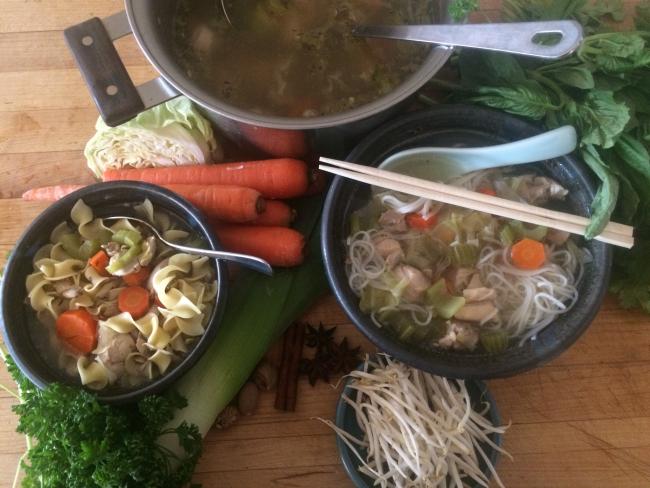You Are What You Eat: Oodles of noodles -- soups for winter
East West Chicken Noodle soup and Pho both kinds.
Wed, 02/22/2017
By Katy Wilkens, MS, RD
When the weather is cold and nasty, there is nothing like a bowl of hot noodle soup to chase away the chills. Chicken noodle soup is a favorite when the cold season hits. Just about everyone eats ramen noodles, and a bowl of Vietnamese pho on a dark winter night can be bliss.
That said, while most canned and packaged soups are quick and easy to prepare, they are far from low in sodium. Several brands range from 900 to 5,000 milligrams per bowl. The average package of ramen noodles is loaded with 1,200 to 4,000 milligrams of salt per serving. That means a single bowl of soup likely contains an entire day’s worth of salt (a moderate amount of salt to eat a day is about 2,000 milligrams). And the chances that you will eat just one bowl of soup all day are slim.
Keeping sodium under control is important because an excess can contribute to high blood pressure and stress on your heart, circulatory system and kidneys.
Food that has a 1:1 ratio of sodium to calories is a good choice. For example, if a food has about 400 calories, expect it to have about 400 milligrams of sodium for a healthy balance. In contrast, the ratio of salt to calorie for most soups is between 5:1 and 10:1, which means you get lots of salt and not much else.
To cut down on sodium:
• Use unsalted butter
• Make your own soup stock from leftover vegetables and chicken; build flavors with fresh and dried herbs
• Avoid ramen soups that come in a cup or that prevent you from portioning out the seasoning
• For ramen in a plastic wrapper, use only ½ teaspoon of the seasoning packet or avoid it all together
• Add your own vegetables and protein to enhance the flavor
Ramen Noodle Soup for Two
2 cups water
1 cup frozen mixed vegetables
1 package ramen noodles
3 ounce diced tofu or canned shrimp, cooked meat, fish or chicken
1 green onion, thinly sliced
½ teaspoon ramen seasoning from packet
½ teaspoon sesame oil (plain or spicy)
Bring water to a boil. Add frozen mixed vegetables, ramen noodles and seasoning. When cooked to desired texture, remove from heat. Add tofu, scallions and sesame oil. If you use canned shrimp instead of tofu, rinse before adding. If you use any other cooked meat, slice it thinly and add it with the vegetables.
Try adding an egg. While the water is boiling, slowly pour in a raw scrambled egg. Keep stirring until the egg is fully incorporated. Serves 2.
Nutritional information:
Calories: 312, Carbohydrates: 43 grams, Protein: 12 grams, Fat: 11 grams, Sodium: 470 milligrams
East/West Chicken Noodle Soup
For Western chicken noodle soup, use creamy yellow egg noodles. For an Eastern flavor, substitute rice noodles and add fresh basil and bean sprouts.
2 pounds chicken breasts or tenders
4-5 cups low sodium or homemade chicken broth
5-6 carrots
2 onions, chopped
2 cups celery, diced
1 cup frozen peas
1 bay leaf
2 leeks or green onions
3 tablespoons butter
1 teaspoon pepper
3 cups egg noodles (or rice noodles)
½ cup fresh parsley or fresh basil, chopped
1 cup fresh bean sprouts (Eastern flavor soup)
Slice carrots, celery, onion and leeks. Cut meat into half-inch cubes. In large pot, melt butter. Add chicken and vegetables, except peas. Cook until onions are translucent. Add broth, parsley and pepper, and then simmer until vegetables are tender, about 30 to 45 minutes. Add egg noodles and peas, and cook until noodles are tender, about 10 minutes. If you use rice noodles, add for the last 5 minutes of cooking, and follow package directions. Add the fresh basil and bean sprouts at the table. Serve with a splash of hot sauce. Serves 8.
Nutritional information:
Calories: 338, Carbohydrates: 30 grams, Protein: 33 grams, Sodium: 179 milligrams
The information in this column is meant for people who want to keep their kidneys healthy and blood pressure down by following a low-sodium diet. In most cases, except for dialysis patients, a diet high in potassium is thought to help lower high blood pressure. These recipes are not intended for people on dialysis without the supervision of a registered dietitian.
[Katy G. Wilkens is a registered dietitian and department head at Northwest Kidney Centers. A recipient of the Susan Knapp Excellence in Education Award from the National Kidney Foundation Council on Renal Nutrition, she has a Master of Science degree in nutritional sciences from the University of Washington. See more of her recipes at www.nwkidney.org.]


